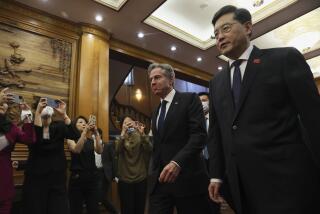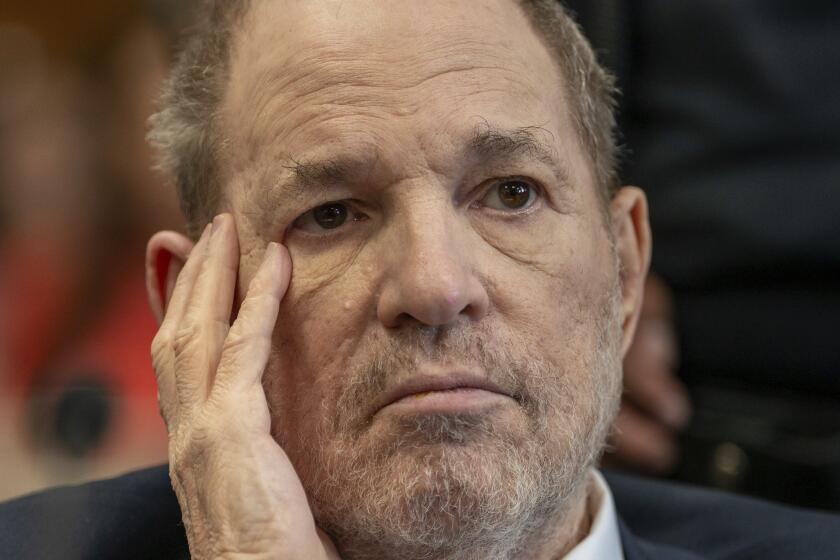China’s Flag Rises Without a Flap
Red-and-blue Taiwanese flags were still fluttering in the most prominent places in Chinatown on Sunday, but a crowd of people loyal to the People’s Republic of China raised split-finger victory signs as their one red-and-gold flag found a home on a small lane.
“I feel real proud,” said David Lee, 85, who owns the office building on Bamboo Lane where the flag now flies. “We’re doing it nicely, quietly. We’ll be in the center [of Chinatown], in time.”
The flag of Taiwan has traditionally flown on rooftops in Chinatown. When Lee and others tried to raise the mainland Chinese flag in the same location about 20 years ago, an angry group of anti-communists tore it down and burned it. Organizers hired security guards to make sure there wasn’t the same kind of trouble Sunday.
This time, there were no critics in the crowd and everyone clapped as teens performed a lion dance in front of the flag and a group of women tapped drums tied to their waists. Opponents of the flag-raising had said they were going to avoid the ceremony.
A passerby from Taiwan expressed indifference about the flag. “It doesn’t matter to me,” said Susan Chang, a 51-year-old native of Taipei who was visiting Chinatown on Sunday. “If they take down this,” she said, pointing to the Taiwan flag, “then I would be angry.”
More than 100 people gathered to watch the flag rise to the strains of “The March of the Volunteers,” the Chinese national anthem.
Many had come from a demonstration in front of the Japanese Embassy, where demonstrators asked the Japanese government to apologize for brutality in China during World War II and to reject new history books that gloss over those actions.
Peter Lau, who heads the group that organized the flag-raising, the China Unity Assn. of Greater Los Angeles, and who also marched in the anti-Japan rally, said it was coincidence that the two events took place on the same day. Still, he said, it was a sign of growing Chinese nationalism.
Raising the flag, in particular, “shows Chinese people overseas are getting stronger,” Lau said through a translator. “More people are thinking about the changing of China.”
Lau said he was overjoyed about the hoisting of the flag in Los Angeles, years after other Chinatowns have raised the mainland Chinese flag. Los Angeles is different, he said, because most of the Chinese-speaking population in Southern California has traditionally supported Taiwan’s Nationalist Party.
Many people from China’s Guangdong province who have migrated to American Chinatowns also supported the Nationalist Party, or Kuomintang, because the founder of the party, Sun Yat-sen, grew up in Guangdong, Lau said.
“People who live here want to keep the tradition they’ve had for 80 years,” he said. “It’s not easy to change that in one day.”
“I just feel so happy because I’ve tried so hard,” he said.
Lau said his group picked Lee’s building on Bamboo Lane because they knew he supported the idea. He said he hopes more red flags with yellow stars will fly in Chinatown in the coming years.
Several people observing the ceremony said they did not see any problem with the Chinese and Taiwanese flags flying so close to each other. They said an upcoming meeting between the men who head the Chinese Communist Party and Taiwan’s Nationalist Party shows that the two sides, which split in 1949 after a civil war, are starting to reconcile.
James Park Loo, 65, said the Nationalists and the mainland Chinese share a belief in a “One China” policy and admire Sun as the founding father of modern China. Loo said that both groups disagree with the Taiwanese who are pushing for their own independent country.
“Certain elements in Taiwan want their own flag, a green flag,” Loo said. “If there’s no green flag, there’s no conflict.”
But Li Jin, 24, said it troubles her to see so many blue-and-red flags flying prominently in Chinatown. The Beijing native, who considers Taiwan part of mainland China, read with emphasis the words on the red banners flying high above the new flag: “United China” and “Against the secession of Taiwan.”
“When I see the KMT [Kuomintang] flag, I feel very sad,” she said. “They are not a country.”
More to Read
Start your day right
Sign up for Essential California for news, features and recommendations from the L.A. Times and beyond in your inbox six days a week.
You may occasionally receive promotional content from the Los Angeles Times.






